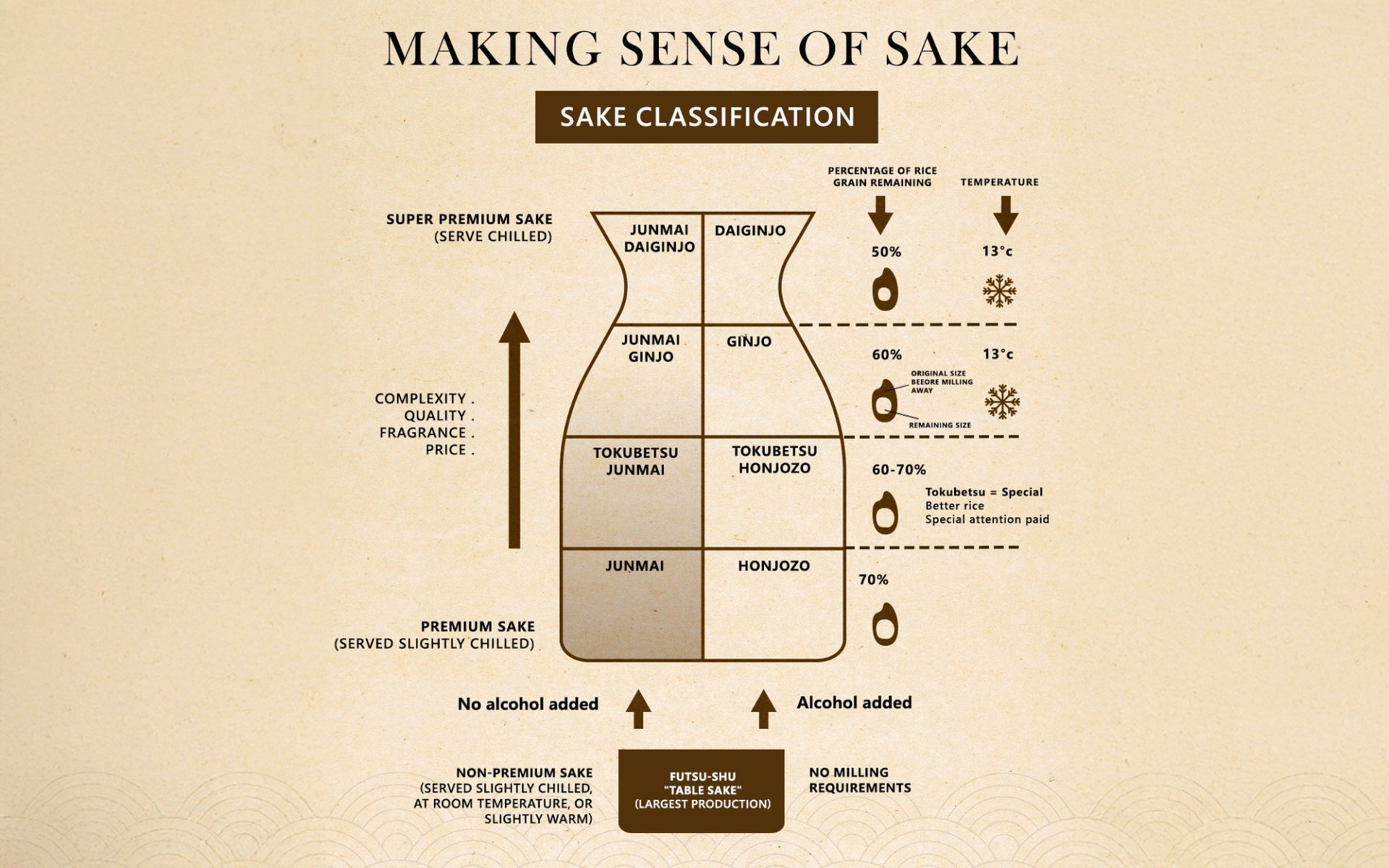Sake Classification

Japan boasts a deeply rooted drinking culture, and Sake perfectly embodies Japanese identity. Just like wine, beer, and other spirits, sake in Japan comes in a variety of tastes and alcohol strengths. In our previous article, we explored the history of sake, but in this piece, we'll guide you through the different types of sake.
What is Sake: The Complex Fundamentals of Production
Sake, often referred to as Japanese rice wine, is a traditional alcoholic beverage globally recognized for its complex flavors and centuries-old cultural significance. One of the key aspects that defines sake's diversity is its classification system, known as "Sake Classification."
Before delving into the sake classification system, it's essential to understand the basics of sake production. Sake is made from just four main ingredients: rice, water, yeast, and koji (koji is a mold grown on steamed rice, resembling green tea). Properly managing koji is considered the secret to producing fine sake. However, the quality of sake is a complex matter determined not only by koji but also by the rice variety, water source, fermentation process, and many other factors.
Sake Classification Based on Rice Polishing Ratio and Alcohol Addition
Sake types are categorized by the amount of rice grain remaining after polishing (Rice Polishing Ratio or Seimai Buai), the production method, and the type of rice used. Generally, there are nine main types, each depending on the rice polishing ratio and whether supplemental alcohol is added.
1. Junmai Daiginjo (純米大吟醸): A super-premium sake made from rice polished to 50% or less of its original size, fermented at a low temperature of 13°C. It's best enjoyed chilled. It boasts complex fruity and floral aromas and a refined taste.
2. Daiginjo (大吟醸): Also a super-premium sake, similar to Junmai Daiginjo, made from rice polished to 50% or less and fermented at 13°C. The difference is that Daiginjo has a small amount of special alcohol added to enhance its aroma and taste. It's best served chilled or at room temperature.
3. Junmai Ginjo (純米吟醸): A premium sake made from rice polished to 60% or less, fermented at a low temperature of 13°C. It's enjoyed chilled or at room temperature, known for its fruity aroma and smooth taste.
4. Ginjo (吟醸): A premium sake similar to Junmai Ginjo, made from rice polished to 60% or less and fermented at 13°C. Ginjo, however, has a special alcohol added. It's best served chilled or at room temperature, lighter in aroma and taste.
5. Tokubetsu Junmai (特別純米): A high-grade sake made from rice polished to 60-70% or using premium rice. It has a slightly savory taste and subtle aroma. It can be enjoyed chilled, at room temperature, or warm.
6. Tokubetsu Honjozo (特別本醸造): A high-grade sake similar to Tokubetsu Junmai, made from rice polished to 60-70% or using premium rice, with special alcohol added. It offers a smooth and easy-to-drink profile.
7. Junmai (純米): A special grade of sake. Originally, rice for this type was legally mandated to be polished to 70%, but now there are no polishing restrictions; only rice, water, and koji are used in production. This results in a sake with distinct color, aroma, and rich flavor, requiring highly skilled techniques and experience to produce. This traditional Japanese sake is often enjoyed warm, paired with dishes like tempura, fish, and meat.
8. Honjozo (本醸造): A special grade of sake, similar to Junmai, made from rice polished to 70% and with added alcohol. It's enjoyed chilled, at room temperature, or warm.
9. Futsushu (普通酒): This is the standard-grade sake widely available in Japan, accounting for up to 80% of all sake production. Most Futsushu often has added alcohol to reduce production costs, making it more affordable and easily accessible. The taste among brands is often quite similar. It can be enjoyed chilled, at room temperature, or warm.
Additional Sake Classifications Based on Production Process
Beyond the categories mentioned above, sake is also classified by its production process, adding to its diversity of flavors and drinking experiences:
1. Nama Sake (生酒) or Fresh Sake: This sake is unpasteurized, allowing it to retain its full, fresh flavor and aroma. It's fresher than other types and often has fruity or yogurt-like notes. It must be served well-chilled and stored in refrigeration.
2. Nigori (にごり): This type of sake is coarsely filtered, meaning some rice particles remain visible, giving it a cloudy, opaque appearance. Because it's not filtered conventionally, it has a rich, sweet flavor and a smooth texture.
3. Genshu (原酒): This sake is undiluted, meaning no water is added at the final stage of production, resulting in a higher alcohol content than usual. While most sakes are around 13-15% ABV, Genshu typically ranges from 17-20% ABV, offering a more robust and intense flavor. It's suitable for drinking on the rocks or as a base for cocktails.


